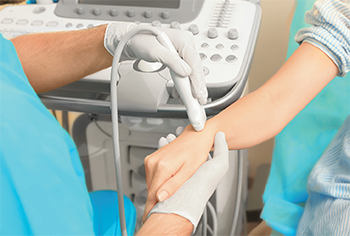
Africa Studio / shutterstock.com
An analysis of treat-to-target therapy assessing two ultrasound definitions of remission for patients with early rheumatoid arthritis (RA) has concluded that using ultrasound remission as a target was not associated with better long-term outcomes for RA patients.1
Compared with MRI, ultrasound costs less, is more accessible and offers the ability to scan more joints in a shorter period of time, but the benefits of structured ultrasound examinations in daily care if patients receive optimal treatment have not been demonstrated, says Siri Lillegraven, MD, MPH, PhD, one of the study’s senior authors and a resident in the Department of Rheumatology at Diakonhjemmet Hospital, Oslo, Norway.
The new paper is a secondary analysis of data from the Norwegian ARCTIC study (aiming for remission in rheumatoid arthritis: a randomized trial examining the benefit of ultrasound in a clinical tight control regimen), published in 2016.2 Starting in 2010, the ARCTIC researchers assessed 238 patients aged 18 to 75 who met ACR/European League Against Rheumatism (EULAR) classification criteria for RA, were naive for disease-modifying anti-rheumatic drugs (DMARDs) and were less than two years from first report of swelling joints to test whether incorporating ultrasound into their treatment strategy led to better outcomes.
One ARCTIC treatment arm, targeting clinical and imaging definitions of remission, incorporated a tight control ultrasound remission strategy using power Doppler and gray-scale assessment for 32 joints. The second arm used conventional tight control aiming for clinical remission. Both groups received a DMARD escalation strategy, with dose escalations based on Disease Activity Score (DAS) response in combination with change in ultrasound scores. Based on the findings, the researchers concluded the systematic use of ultrasound in follow-up of patients with RA according to current recommendations is not justified.
What Should Be the Target?
Treat to target is a dynamic treatment strategy that uses a specific testing goal to indicate whether treatment has achieved either disease remission—absence of signs and symptoms of the disease—or low disease state. Testing is done frequently, for example, every one to three months. If the target is not being reached, then medical treatments are changed or supplemented with new therapies. This approach encourages doctors to treat more often and more aggressively if the treatment plan is not producing desired results. For early RA, it is widely accepted as a way to achieve better long-term outcomes—with fewer symptoms and higher remission rates.
But there is less agreement on what the target should be—how remission is determined, Dr. Lillegraven notes. Multiple criteria are used in current clinical practice, including physical exams; radiographic evidence; and composite measures, such as DAS28 and the ACR/EULAR 2011 Remission Criteria for RA, which use Boolean or index-based criteria.3
“What we did in ARCTIC was to treat based on subclinical inflammation, assessed by ultrasound,” she explains. “The ARCTIC physicians and researchers hypothesized that follow-up with ultrasound was beneficial and would lead to better outcomes. But when we analyzed the results from using ultrasound as part of treat to target, there was no difference between the two groups, with or without ultrasound, in almost all parameters,” she says. The current secondary analyses instead supported the ACR/EULAR standard of Boolean (yes or no) remission in 44 joints as the preferred treatment target in early RA.
“We know ultrasound can be useful in diagnosing RA in early stages or in patients who don’t have swollen joints, but [do] have subclinical inflammation that can be identified by ultrasound.” It still has an important place in rheumatology practice, Dr. Lillegraven tells TR, but not necessarily on every doctor’s visit. “We haven’t stopped using ultrasound in our clinics as a diagnostic aid in RA. We still use it in our department, but no longer to detect subclinical inflammation in a treat-to-target setting.”
Compared with MRI, ultrasound costs less, is more accessible & offers the ability to scan more joints in a shorter period of time, but the benefits of structured ultrasound examinations in daily care if patients receive optimal treatment have not been demonstrated.
Other Takes
Another recent study, called TaSER (targeting synovitis in early rheumatoid arthritis), also studied whether musculoskeletal ultrasound assessment of disease activity in early RA could improve treat-to-target strategies.4 It found that an ultrasound-
driven treat-to-target strategy in early RA led to more intensive treatment, but not better clinical outcomes than a DAS28-driven strategy.
The ARCTIC researchers, in another recent paper, specifically examined the usefulness of ultrasonography in guiding intra-articular injections and found ultrasound information to be useful when selecting joints for injection.5 “But we found no difference in efficacy of ultrasound vs. palpation-guided injections,” says Dr. Lillegraven.
The major take-home message for rheumatologists from the ARCTIC study is that achieving remission is possible for the majority of RA patients. “We can see so many more of our patients in remission than just 10 years ago. But that’s if you use tight controls and treat to target. We have ended up with better outcomes, which have pushed us toward treat to target, tighter control and specific targets,” Dr. Lillegraven says. “It’s important to treat patients early in the disease and see them often in the beginning while treating to specific targets, even though that approach can be more time consuming. It will produce better long-term results.”
Ten years ago, rheumatologists might have asked their RA patients how they were doing, and if they said they were doing fine, the doctor might not have considered changing their treatments. “Now we’re moving toward more formal approaches and more persistence in changing treatments in order to get our patients into remission,” Dr. Lillegraven says. “We know that being in remission is associated with better long-term results, while not trying to achieve remission leads to worse outcomes.”
But some clinicians might find the recommended targets too stringent, Dr. Lillegraven adds. “Some patients will never reach zero on the global assessment of disease activity scale, and thus would never achieve remission by that standard. That is a limitation of treat to target where established disease is present. For some patients, the target of remission can lead to over-treatment, where low disease activity might be a more appropriate target.”
Larry Beresford is a medical journalist in Oakland, Calif.
References
- Paulshus Sundislaeter N, Aga AB, Olsen IC, et al. Clinical and ultrasound remission after 6 months of treat-to-target therapy in early rheumatoid arthritis: Associations to future good radiographic and physical outcomes. Ann Rheum Disease. 2018 Oct;77(10):1421–1425.
- Haavardsholm EA, Aga AB, Olsen IC, et al. Ultrasound in management of rheumatoid arthritis: ARCTIC randomized controlled strategy trial. BMJ. 2016 Aug 16;354:i4205.
- Holzman D. New criteria for RA remission. The Rheumatologist. 2011 Feb;5(2).
- Dale J, Stirling A, Zhang R, et al. Targeting ultrasound remission in early rheumatoid arthritis: The results of the TaSER study, a randomized clinical trial. Ann Rheum Dis. 2016 Jun;75(6):1043–1050.
- Nordberg LB, Lillegraven S, Aga AB, et al. The impact of ultrasound on the use and efficacy of intraarticular glucocorticoid injections in early rheumatoid arthritis: Secondary analyses from a randomized trial examining the benefit of ultrasound in a clinical tight control regimen. Arthritis Rheumatol. 2018 Aug;70(8):1192–1199.

